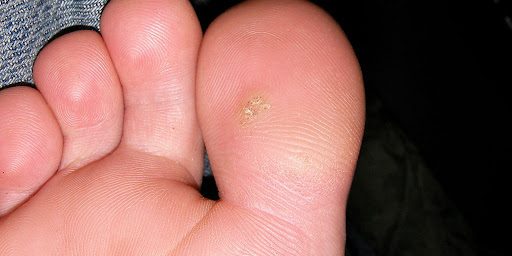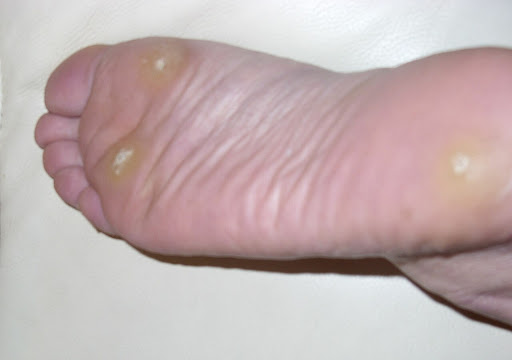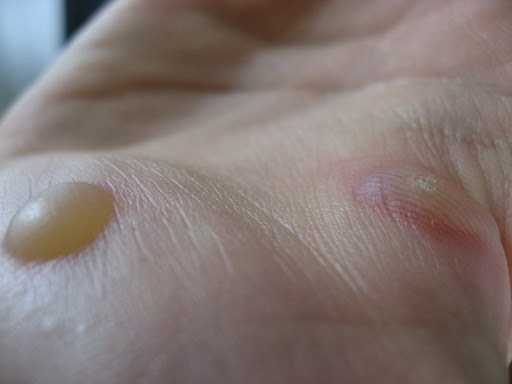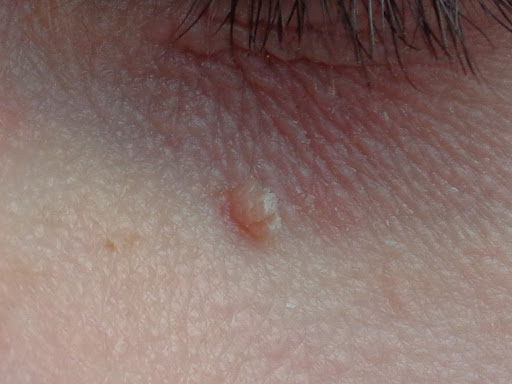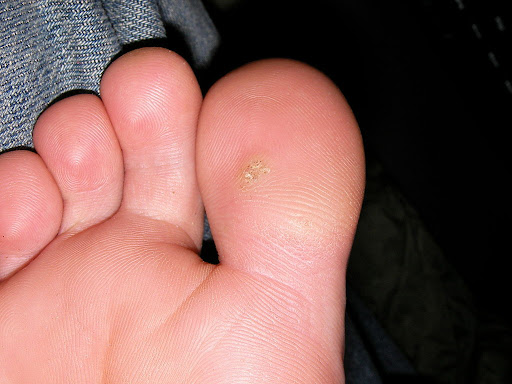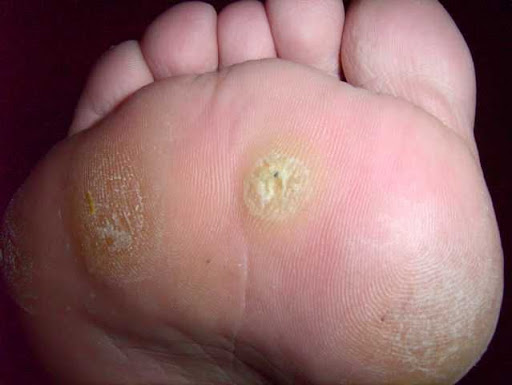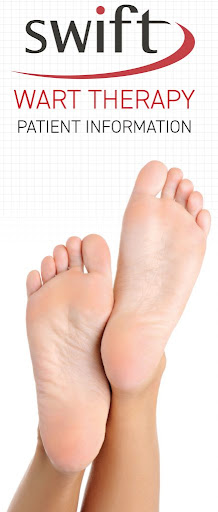Plantar warts, periungual warts and even common warts can grow on the feet. Most skin warts are contagious. Foot warts are caused by viral infections, causing pain and discomfort that can affect your day-to-day activities.
Warts on a foot (Image Source: Marionette/Wikimedia Commons)
Although foot warts may go away on their own, various treatment options are available. In this post, we’ll discuss the types of warts that grow on the feet. We’ll also cover their symptoms, causes and treatment.
What are Warts?
Image Source: Kai Hendry/flickr.com
A wart is a viral infection caused by the human papillomavirus (HPV). It is a skin infection that triggers the growth of extra cells. It makes the affected outer skin layer become thick and hard.
Warts can grow on any part of the body but often appear on the hands and feet. Most warts are non-cancerous skin growth with a size range of one to 50 millimetres.
Kids and teens are more at risk of getting warts than adults because their immune systems are not strong enough to fight off various types of HPV strains. However, an adult with a weakened immune system due to chronic skin conditions or viral infections (HIV) can also be more susceptible to having warts.
Generally, warts are highly contagious and can spread through direct contact. But immune system responses to HPV strains vary from person to person. Thus, not everyone who comes in contact with HPV can have this skin condition.
Most warts are harmless and resolve on their own. However, they can be bothersome and embarrassing to have so you may want to treat warts with home remedies.
But not all warts respond to “at-home treatments”. This is why you should consider seeking help from a general practitioner (doctor).
Types of Warts
Several types of warts grow on the body. They differ in appearance, depending on which part of the body they grow.
1. Common Warts
Common warts can grow on any part of the body. However, they often appear on the knees and the backs of the fingers and toes.
Common warts are rough and grainy with a rounded top. They usually resemble a cauliflower and appear greyer than the surrounding skin.
These types of warts may appear in groups or alone. Typically, they are not serious or painful and may go away without treatment.
2. Flat Warts
These types of warts grow on the face, arms and thighs. Their tops are distinctively flat as if they have just been scraped. Whilst also known as juvenile warts, they are common in children and can spread easily through direct contact.
Flat warts can form large groups or clusters. However, they are so small that you may not notice them immediately. They appear in different colours such as flesh, pink, brownish, or slightly yellow.
Like common warts, flat warts are harmless and may go away on their own.
3. Filiform warts
Image Source: AfroBrazilian/Wikimedia Commons
Filiform warts occur around the nose or mouth whilst some of them can grow on the neck or under the chin. But since they are contagious, they can easily spread to other parts of the body.
Filiform warts are small and take on the appearance of a tag or tiny flap of skin, often projecting off your skin in thin, finger-like strands. They are usually the same colour as your skin.
These warts are painless except when they develop in a fold in your skin and other sensitive areas of your body.
4. Genital warts
Warts that grow on, in and around the genitals are usually small, scattered, skin-coloured bumps. They may also look like a cluster of bumps resembling a cauliflower.
Genital warts can vary in size. Whilst most warts are recognisable, genital warts can be too small to spot and only detectable through a medical examination. That said, they can also grow larger, joining other warts to create clusters that are over a centimetre in diameter.
There are over 100 types of HPV that cause warts. Nearly all HPV types lead to relatively non-cancerous warts that grow on your hands or feet.
However, a few strains of HPV can cause warts to grow on, in, and around your genitals. High-risk HPV infection is linked to higher chances of developing various cancers such as vaginal, vulvar, penile, anal and cervical cancer.
5. Foot Warts
Periungual and plantar warts are painful rough bumps found on the foot. Foot warts are categorised based on where they are located. Periungual warts grow on the toes whilst plantar warts grow on the soles of the feet.
What are Periungual Warts?
Image Source: Dewdude/Wikimedia Commons
These types of foot warts develop beneath and around the fingernails and toenails. They are painful and can interfere with nail growth.
Initially, they are small, roughly the size of a pinprick, but they can expand over time and spread to adjacent areas through direct contact. They often have a rough texture and may resemble cauliflower.
Signs and Symptoms of Periungual Warts
- Rough growth surrounding or beneath the nail
- Pain when they increase in size
- Split skin around the nail
- Altered appearance of the nail and cuticle
What are Plantar Warts?
Image Source: Marionette/Wikimedia Commons
Plantar warts develop on the soles of the feet, and unlike other warts, they grow into the skin rather than protruding from it. Anyone can develop plantar warts, but kids and teens are more at risk.
Plantar warts can disrupt the normal skin lines typically present on the soles of the feet. These warts often appear as raised, rough growths on the sole, and they can cause discomfort while walking or standing due to their location and impact on the skin’s surface. You can identify a plantar wart by observing what seems like a small hole in the bottom of your foot, surrounded by hardened skin.
Symptoms of Plantar Warts
- A cluster of small lumpy growths or a single rough growth on the sole.
- Hard, thickened skin at the location where the wart grows into the skin.
- Presence of black or brownish dots, which are burst capillaries.
- Pain experienced while walking or standing.
Two types of plantar warts can grow on the sole.
Types of Plantar Warts
1. Myrmecial-type Plantar Warts
These warts develop due to an infection from HPV-1. They look like domed, smooth-surfaced lesions.
Myrmecial-type plantar warts may contain black or brownish dots, which are small burst blood vessels. These warts often cause discomfort when a person is walking or standing.
Signs and Symptoms of Myrmecial-type Plantar Warts
- Deep, soft bumps that grow inwards as a result of standing or walking
- Pain experienced with direct pressure
- Sensation similar to stepping on pebbles
- Callus-like yellowish skin
- Presence of black dots
2. Mosaic-type Plantar Warts
Mosaic warts are clusters of plantar warts that are tightly grouped. These warts are caused by HPV-2 infection. They typically have a flatter appearance and are less painful compared to myrmecial plantar warts.
Signs and Symptoms of Mosaic-type Plantar Warts
- Small surface-level skin growths
- Clusters of multiple warts resembling a mosaic pattern
- Less painful than myrmecial warts
Plantar Wart Treatment Options
Warts often resolve on their own without treatment but this can take anywhere from several weeks to years. The immune system can gradually clear the virus responsible for warts, leading to their disappearance. However, individuals with compromised immune systems may experience more difficulty in getting rid of warts.
Doctors have several treatment options for warts:
- Cryotherapy freezes the warts using medication, usually liquid nitrogen.
- Cantharidin induces a blister beneath the wart to cut off its blood supply.
- Electrosurgery and curettage involve scraping and burning the wart.
- Excision removes the wart through surgery.
In cases of stubborn warts, dermatologists may recommend laser treatment or immunotherapy.
You may also try various home remedies for wart treatment, such as using products containing salicylic acid or attempting the duct tape method.
When attempting salicylic acid treatment at home to remove warts, it’s crucial to adhere to the instructions provided on the product packaging or as directed by a general practitioner.
Typically, the process involves the following steps:
- Soak the wart in warm water for about five minutes. This helps soften the skin and makes the treatment more effective.
- After soaking, thoroughly dry the skin surrounding the wart.
- Apply the salicylic acid treatment to the wart as per the product’s instructions.
- Repeat these steps daily as recommended for the specified duration.
What Can We Do at Adelaide Foot and Ankle?
Adelaide Foot and Ankle have been treating warts for many years. We offer a wide range of wart treatments, from mild to more intense options for the most stubborn warts. Our range of treatment solutions includes the latest SWIFT Wart Therapy.
SWIFT is a medical device that uses microwaves to remove warts, verrucae and papillomas. During treatment, a process called “Heat Shock” makes the wart release proteins into the circulatory system. This tells the immune system to fight the HPV infection that causes the development of warts.
Request an Appointment to See Us Today
Our podiatrists and podiatry team at Adelaide Foot and Ankle have a combined experience of 70 years regarding foot and ankle care. They are experts in diagnosing and treating warts using various treatment methods.
We’re here for you if you need help with plantar warts. Put your feet in our hands. See your Adelaide podiatrist today
FAQs
1. What is the difference between a plantar wart and a wart?
Plantar warts are different from most warts because they grow inwards, not outwards. They dig into the tough skin on the sole, causing discomfort or pain.
2. What does a plantar wart look like?
Plantar warts look flat and round with a tiny dent in the middle.
3. What can be mistaken for warts on feet?
Plantar warts are sometimes mistaken for calluses or corns, which can lead to them being left untreated. Therefore, it is crucial to have a podiatrist thoroughly assess the foot to provide an accurate diagnosis and develop an appropriate treatment plan.

